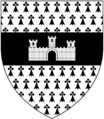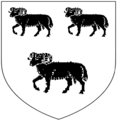Kerswell Priory facts for kids
Kerswell Priory (also known as Carswell) was a small monastery in the village of Broadhembury in Devon, England. It was home to a group of monks called Cluniacs.
Contents
History of Kerswell Priory
Kerswell Priory was founded a long time ago, between 1119 and 1129. Historians have slightly different ideas about its beginnings. George Oliver, a church historian, believed it was a "cell" (a small branch) of Montacute Priory in Somerset. However, William Pole, a Devon historian, thought it was connected to Canonsleigh Abbey in Devon.
The land for the priory was given by Matilda Peverel. She was the daughter of Pagan Peverel, a knight who fought in the First Crusade.
In 1291–1292, the priory was valued at £2 1s 8d. It owned land in Kerswell, Monk Culm, and Sampford Peverell. During the 1300s and 1400s, England was at war with Aquitaine (a region in France). Because Kerswell Priory was an "alien priory" (meaning it was controlled by a foreign monastery), the King sometimes took it over. However, it was given back to the monks in 1312. Records from 1374 show that the head monk (the prior) didn't actually live at Kerswell Priory.
When the Priory Closed
By the 1500s, only two monks lived at Kerswell Priory. In 1534, it was valued at £28 16s 4d. The head monk at that time was Thomas Chard.
The priory was officially closed in 1538 or 1539. This was part of a big event called the Dissolution of the Monasteries, when King Henry VIII closed many monasteries across England. After it closed, King Henry VIII gave the priory to John Etherydge. Later, during the time of Queen Elizabeth I, William Rosewell bought it. He was a lawyer for the Queen. The property then passed down to his grandson, Sir Henry Rosewell.
Later Owners of Priory
In the early 1600s, the estate, then known simply as "Priory," became the home of Edward Hill. His son, Richard Hill (1655–1737), lived there too. Richard Hill was known for being very kind and generous. He was a good husband, father, and friend. He died in 1737 at 82 years old.
The Hill family's coat of arms, which is like a family symbol, showed a castle with three towers.
Later, the property passed to the Sydenham family. Humphrey Sydenham (1694–1757) was a lawyer and a Member of Parliament for Exeter. He married Grace Hill, who was one of Richard Hill's daughters. Humphrey Sydenham faced financial problems but later received a large inheritance that helped him. His monument in Dulverton church describes him as a very good person who loved his country and was kind to everyone.
Another family member, St Barbe Sydenham (died 1799), also lived at Priory. He married his cousin, Ellery Williams. After St Barbe Sydenham died without sons, the property eventually passed to a cousin.
What the Site Looks Like Today
Today, a house stands where Kerswell Priory used to be. This house is very old, with parts from the late 1500s and changes made in the 1600s and 1700s. It might be built over old stone and cob (a mix of clay, sand, and straw). The house even has a stone doorway from the 1100s that was moved there! It's important because of its old features and what it tells us about the priory's history.
South of the house, you can still see the remains of the old dining hall, called the refectory. It was rebuilt in the 1800s and 1900s, but parts of it are from the late 1400s or early 1500s. Even though it's a ruin without a roof now, it's still protected because it's part of the old priory. It used to have a special medieval roof, which was taken down and stored in 1984.
Images for kids






